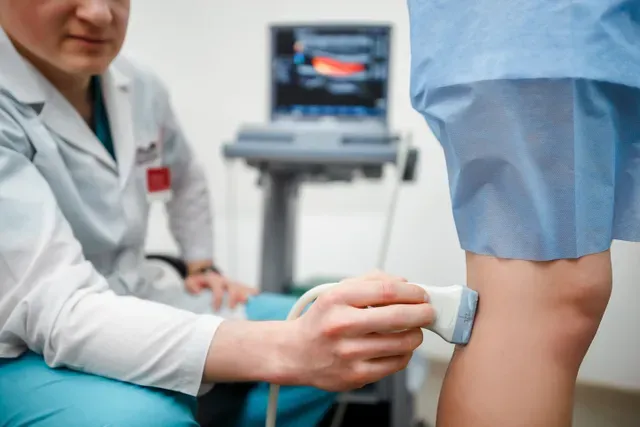Vein Mapping and Venous Ultrasounds
Offered in East Orange and Newark, NJ
If you are experiencing symptoms with your veins, venous ultrasounds, and vein mapping are valuable tools for identifying your condition and planning treatment. Vein mapping and venous ultrasounds are advanced imaging procedures that help diagnose and treat a variety of vascular conditions. They are non-invasive tests using high-frequency sound waves to create detailed images of the blood flow within your veins and arteries.
At Newark Vein and Vascular Center, LLC, we serve Newark, NJ, and surrounding areas with these advanced methods of diagnosing venous disorders like spider veins, varicose veins, and venous insufficiency.
Venous Ultrasound vs. Vein Mapping
A venous ultrasound is an imaging test that uses sound waves to view the blood flow in your veins. It allows doctors to see the structure of your blood vessels and how well blood flows through them. On the other hand, vein mapping, also known as venous mapping, involves using an ultrasound examination to map out the location, size, and flow direction of veins, especially the great saphenous vein and other superficial veins. This is particularly useful for planning procedures like bypass surgery or vein grafts.
Though vein mapping uses tools and methods similar to an ultrasound, it has a different purpose. During a vein mapping ultrasound study, one of our registered vascular technicians uses an ultrasound probe to construct images of your veins. Beginning at the groin area and following your veins down to your ankles, we carefully measure blood flow through the valves while stitching together several images, forming a vein map of the entire region being tested. It can be used to examine for any of the following:
- Enlarged veins
- Irregular twisting
- Deep vein thrombosis (DVT)
- Other abnormalities
Further, insurance providers require vein mapping ultrasound studies to see if patients meet certain criteria. Without this study, it is impossible to expertly assess your veins and determine the best treatment plan you require.
What to Expect From Venous Ultrasound & Vein Mapping?
Usually, ultrasounds and vein mapping don’t require any special preparation. It’s also recommended to wear loose-fitting clothing over whatever part of your body will be screened. This will make the procedure easier for your doctor and more comfortable.
During a venous ultrasound, you will lie on an exam table while a technologist applies a small ultrasound probe device to various skin locations. The probe sends sound waves that bounce off your blood cells and return to the probe, creating an ultrasound image on a screen. The procedure is painless, requires no special preparation, and you can return to normal activities immediately afterward.
- The technician will coat the area to be tested with a warm gel to transmit waves more effectively.
- A handheld device called a transducer will be placed and moved over the area, emitting high-frequency sound waves and recording their echoes.
- The echoes are recorded on a computer screen or monitor, forming an image of your vein structure and your blood cells as they flow.
Similarly, during vein mapping, the technologist uses the ultrasound probe to visualize the veins in your legs, precisely the greater saphenous vein. During this procedure, you may be asked to stand, sit, or lie down. Unlike other services that can take up to 90 minutes to complete, either procedure takes only about 25-45 minutes. You can return to normal activities immediately after leaving the examining room.
Who Can Benefit From Venous Ultrasound & Vein Mapping?
Patients with symptoms of venous insufficiency or varicose veins or those preparing for vascular surgery can significantly benefit from these imaging tests. They are also used to monitor the condition of vein grafts post-surgery.
At Newark Vein and Vascular Center, LLC, we often use ultrasounds and vein mapping to test for venous insufficiency. This condition is caused when the valves in your leg veins fail, allowing blood to flow backward and accumulate in your veins. You might be struggling with venous insufficiency if you are experiencing the following symptoms:
- Swelling in your legs or ankles
- Discolored skin near the ankles
- Itchy or burning sensations
- Restless leg syndrome
- Pain when walking
- Painful leg cramps or spasms
Venous insufficiency can also cause varicose veins, which twist and bulge like ropes under your skin. Spider veins are a milder version of this. While they do not bulge, spider veins are visible as clusters of purplish blood vessels visible through your skin that resemble tree branches or spider webs on the leg or face.
Benefits of Venous Ultrasound
A venous ultrasound is a crucial tool in diagnosing conditions like venous insufficiency, varicose veins, and thrombosis. It’s a non-invasive, painless procedure that doesn’t use radiation. This test allows doctors to see your veins’ structure and assess the blood flow, providing valuable information for treatment planning.
Benefits of Vein Mapping
Vein mapping provides a detailed map of your vein anatomy, which is invaluable for surgeons planning procedures like bypass surgery or creating a fistula for dialysis. It helps identify the most suitable veins for these procedures, increasing the chances of successful treatment.
Schedule A Venous Ultrasound Or Vein Mapping Today
If you are experiencing symptoms of venous insufficiency, varicose veins, or spider veins, have your veins tested by an accredited provider like Newark Vein and Vascular Center, LLC. Accreditation is key, as it demonstrates our commitment to quality patient care. What’s more, we’re the only location in Newark, NJ, offering comprehensive vein treatment. Contact us today to get started on your road to better vein health through venous ultrasound or vein mapping.

